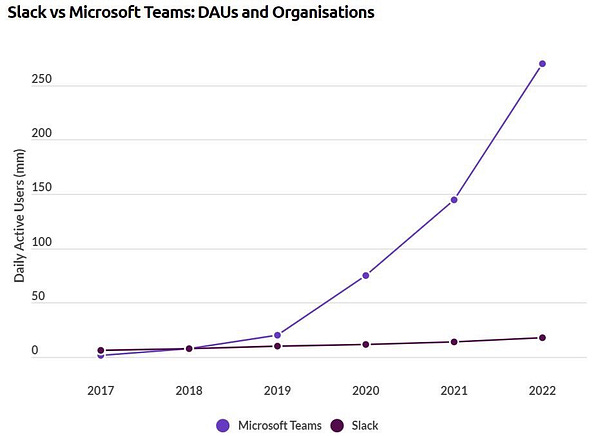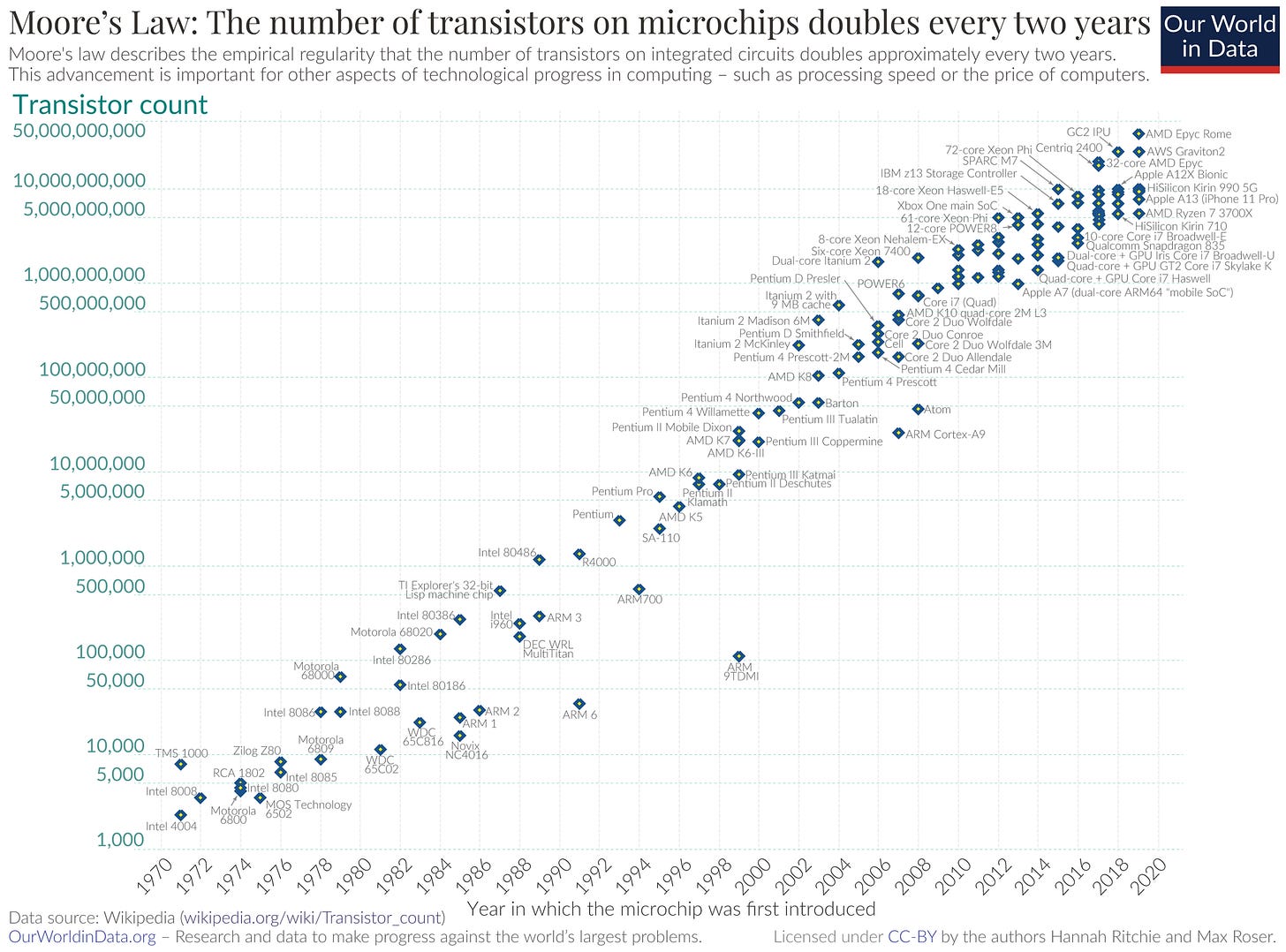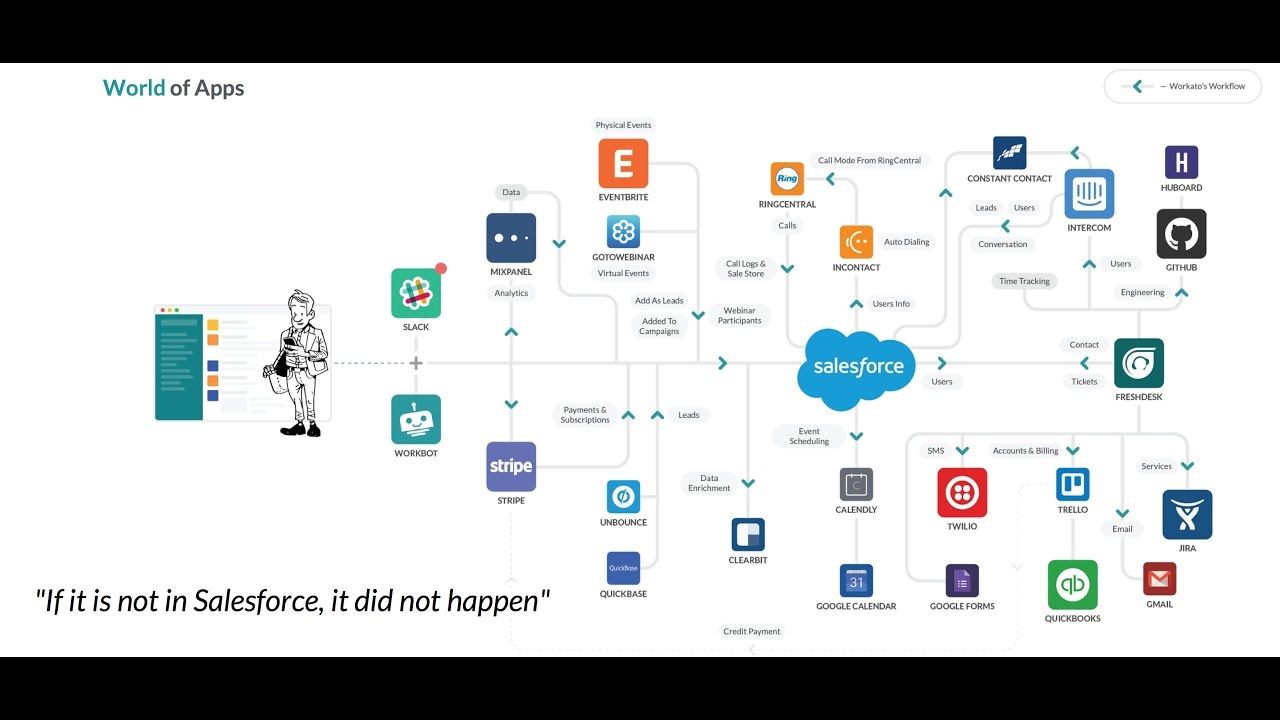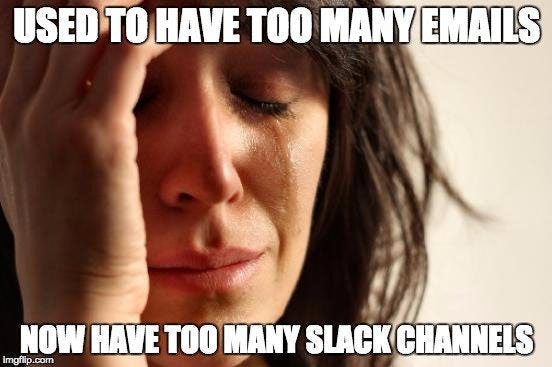The castle below is your product, and we’re going to talk about how you can build a moat around it. If you’re a startup competing with large incumbents, this is for you. If you are a category creator, this is for you. In short, every business and product should be thinking about defensibility.
We’ll start by looking at why moats are critical, and then look at how B2B SaaS products can build moats.
Let’s dig in.
Why is this important?
Building a moat today is critical.
The amount of computing power doubles every two years according to Moore’s law. Applying this to software more generally: it’s becoming easier and faster to product software.
This really means two things:
Software becomes more accessible. I don’t need to know how to code to build an application, I can use Bubble or a different no code tool.
Time to market reduces. If you’re starting a SaaS company today, you can have an MVP running in days: Stripe for payments, Firebase for hosting, Google Analytics to understand where your traffic is coming etc.
If you launch a new product today, expect competitors to land in your space in weeks or months. If you have an existing product, expect new entrants to constantly try and disrupt your vertical.
A framework for moats
Jerry Neuman’s taxonomy of moats is one of the best pieces I’ve read on this subject.
Jerry writes more generally about moats and identifies the following categories:
State granted: you have access to something that no one else / few others do.
Special know-how: your company has information that others don’t have.
Scale: you’ve achieved scale that allows you to produce something for cheaper or provides more value to your users.
Rigidity: it’s difficult for customers to stop using your product.
The moats in B2B SaaS fall into the “scale” and “rigidity” categories.
Unique access is not really moat in B2B because it’s a software play. One could argue that building a SaaS product for the government falls under this category, but it feels like an exception rather than a rule.
I’m not convinced that special know-how exists in B2B SaaS. Consider a software company that has the best trading algorithm. By definition, this company shouldn’t provide a service, it should raise money, invest it and sow the rewards. In other words, if a software company has some “secret sauce”, it will create value using the secret sauce and not by offering a SaaS product.
Moats in B2B SaaS
These are the most important moats in B2B SaaS. I’ve included a real-life example for each one.
Integrations / ecosystem
If a software product integrates with many other software products or has a large ecosystem of apps, it’s difficult for customers to switch.
For example, a company like Salesforce has more integrations than most other CRM tools. If you’re a Salesforce customer, it will take you time to switch to a different tool. You need to hook up your website, your financial planning system, your business intelligence tool etc etc. Similarly, Shopify has a great app ecosystem. If you’re using a bunch of plugins to manage your e-commerce business, moving to an alternative is time consuming and costly.
Learning curve
If an organisation has invested significant resources in getting their workforce to learn a software product, it’s a moat. If they ever wanted to switch, there are two costs: the difference in financial cost between the two products, and the cost of time to train the workforce. This is a bit of dichotomy: ideally, you want make your product as simple as possible to use. At the same time, you want to users really used to your product so that the cost of switching away is too much.
For example, if your company has invested in a business intelligence tool like Looker, it’s going to be difficult to switch away and train your entire workforce from scratch.
Data lock-in
If, by using your product, a customer builds valuable data that cannot be transferred out of your application, you have a moat.
The best example of this is Slack. If you decide to migrate away from Slack, you’ll need to give up your company’s messaging history. This isn’t easy because a lot of useful information lives on Slack.
Long-term contracts
Locking customers into a long-term contracts is a moat. Every SaaS company on the planet offers monthly pricing and a discounted annual price. The discounted annual price helps in two ways. First, it’s cash flow for the company. Second, it locks you in for a year. A year is a long time, and it might actually build a different moat — by getting users used to the product and increasing switching costs.
Bundling
If you’re a large incumbent, bundling can be a moat.
Microsoft spotted Slack’s popularity and launched Teams. Microsoft has the distribution and took advantage of it. Whilst people have their opinions about the products (Slack wins hands down IMO), it’s difficult for a CFO to justify additional expense.


More importantly, the bundling might offer unique advantages. In the case of Teams, flawless integration with Microsoft Office. Yes, Slack has a great marketplace and excellent integrations. But that’s not the point. The point is Slack relies on Microsoft to expose data via APIs. Teams does not. It has unlimited access to every Microsoft user.
Trust
If you are the most trust worthy competitor, this can be a moat. Consider certifications like SOC2 or HIPAA, many enterprise companies will require this before working with you. These won’t last long though — there are SaaS companies that help you get these certifications up and running in no time. You’ll need to find a different way to build trust.
Time vs. moats
An interesting thought exercise for B2B SaaS startups is to think about moats on the vector of time.
Generally speaking, startups have no moat when they start. They are able to challenge incumbents because they solve a unique problem. Incumbents have a large customer base that they must serve. They don’t or can’t innovate immediately because this might hurt their existing customer base.
Looking at the moats above, startups are best placed to form moats in the learning curve and data-lock in categories. These moats do not require scale. Integrations can also help but they take time. There are also companies like Airbyte and Segment that make integrations a breeze.
Long-term contracts are hard, but not impossible. If you’re a small, unproven startup it is hard to lock in a customer for years. Bundling becomes relevant only much later in a company’s journey — once they’ve decided to expand horizontally.
In general:
The strength of your moat is proportional the time it took you to build it.
To close
Here’s what you should takeaway from this:
Building and producing content is getting cheaper everyday. Defensibility is important.
Moats in B2B SaaS: integrations / ecosystem, learning curve, data lock-in, long-term contracts, bundling and trust.
It’s important to think about moats against the vector of time for your startup.
The strength of your moat is proportional to the time it’s taken you to build it.







